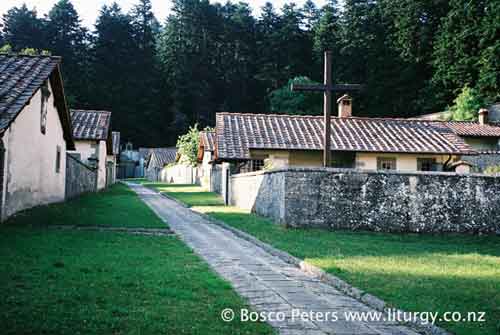 There is a special place in my heart and personal spirituality for Camaldoli (my photo above), St Romuald, and the Camaldolese. This year the Camaldolese Benedictines are commemorating the 1,000th anniversary of the foundation of their motherhouse in Camaldoli, Italy, where St. Romuald encouraged the vocation of some monks to live in solitude as hermits. I have visited Camaldoli (the hermitage and the cenobium), and St Gregory’s, their monastery in Rome, and stayed at New Camaldoli, Big Sur, in California, and visited Incarnation Monastery, Berkeley. [The links are to some of the photos I took].
There is a special place in my heart and personal spirituality for Camaldoli (my photo above), St Romuald, and the Camaldolese. This year the Camaldolese Benedictines are commemorating the 1,000th anniversary of the foundation of their motherhouse in Camaldoli, Italy, where St. Romuald encouraged the vocation of some monks to live in solitude as hermits. I have visited Camaldoli (the hermitage and the cenobium), and St Gregory’s, their monastery in Rome, and stayed at New Camaldoli, Big Sur, in California, and visited Incarnation Monastery, Berkeley. [The links are to some of the photos I took].
Camaldolese have recluses, hermits, monastics living in community, and involved in apostolic ministry. And you can move from one of those modes of life to another. Their central focus, that holds all this together, is contemplative life. They also have Oblates.
St Augustine of Canterbury, of course, set off from St Gregory’s in Rome, having been prior there. The Episcopalian/Anglican Order of the Holy Cross has a special association with the Camaldolese – to the point of having shared a monastery together, drawing on each others’ insights, and mutually enriching each others’ lives and spirituality.
There is a particular focus on ecumenism and interreligious dialogue.
As part of the millennium celebrations the Pope and the Archbishop of Canterbury have prayed together at St Gregory’s.
Archbishop’s homily at vespers, St Gregory’s
Monastic Virtues and Ecumenical Hopes – Archbishop of Canterbury address at St Gregory’s (a conference presented with my friend, Fr. Robert Hale, prior of the New Camaldoli Hermitage in Big Sur, California).
Monks and Mission: a perspective from England address of the Archbishop of Canterbury at the Abbey of Monte Cassino.
The Archbishop of Canterbury’s sermon on March 11 at St. Paul’s Within the Walls, an Episcopal Church parish and the first non-Roman Catholic church to be built inside the walls of Rome. The St. Paul’s congregation was joined by members of All Saints Anglican Church in Rome, a parish in the Church of England’s Diocese in Europe, for the service:



As you and I both know, Bosco, the Religious Life can be an oasis of calm in the midst of a busy world – a place where vocation can be either nurtured or, sometimes, sadly stifled.
Perhaps its greatest benefit for the world, is the essence of the prayers, the Sacramental life, and the SILENCE that can be offered – in hospitality – to others, as well as the Community itself.
I was impressed with Archbishop Rowan’s sermon at St.Paul’s Episcopal Church in Rome, where he spoke of the ‘factories’ of religion, where success would seem to be the prime preoccupation.
One hopes that he has this in mind, also, for the outcome of the Covenant process in the Anglican Communion.
It is good to realise that – even by the ABC’s parameters – our human successes can sometimes be inimical to what God may really require of us. Hospitality and openness to God may be more important than the idolatry of our own vision. A truly sobering thought.
I agree, Fr Ron. We so often focus on ways to get people into our pews – based on advertising and recruiting models of “the world”. And at the neglect of what makes us church: our life of sacrament and prayer, our service of those in need, … It continues to fascinate me that worship is not one of the “five-fold mission” of Anglicanism. Blessings.